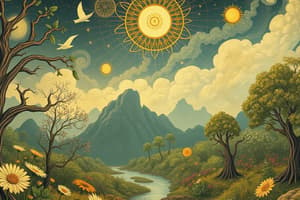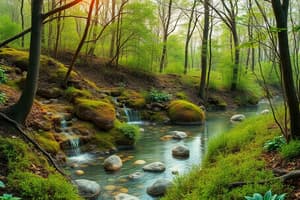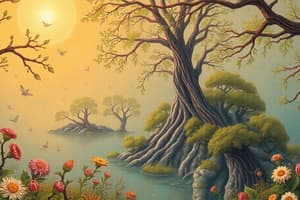Podcast
Questions and Answers
Which definition most accurately describes ecology, as initially conceived by Ernst Haeckel?
Which definition most accurately describes ecology, as initially conceived by Ernst Haeckel?
- The study of the interactions among organisms and between organisms and their abiotic environment. (correct)
- The branch of biology focusing on the classification of species.
- The study of the Earth's atmosphere, hydrosphere, and lithosphere.
- The study of energy flow and nutrient cycling within an environment.
Considering the hierarchical levels of organization in ecology, which sequence accurately represents the progression from simplest to most complex?
Considering the hierarchical levels of organization in ecology, which sequence accurately represents the progression from simplest to most complex?
- Individual → Community → Population → Ecosystem → Biosphere → Biome
- Biosphere → Biome → Ecosystem → Community → Population → Individual
- Ecosystem → Community → Population → Individual → Biome → Biosphere
- Individual → Population → Community → Ecosystem → Biome → Biosphere (correct)
What is the key distinction between how Eugene P. Odum and A.G. Tansley defined an ecosystem?
What is the key distinction between how Eugene P. Odum and A.G. Tansley defined an ecosystem?
- There is no distinction; both scientists described the ecosystem in the same terms.
- Tansley focused on the functional aspects, while Odum highlighted the structural components.
- Odum emphasized the importance of abiotic factors, whereas Tansley concentrated on biotic elements.
- Tansley coined the term, while Odum elaborated on the interactions within the unit. (correct)
Which concept correctly describes the biosphere?
Which concept correctly describes the biosphere?
How do aquatic and terrestrial ecosystems primarily differ?
How do aquatic and terrestrial ecosystems primarily differ?
Which statement accurately captures the relationship between abiotic and biotic components of an ecosystem?
Which statement accurately captures the relationship between abiotic and biotic components of an ecosystem?
How do producers, consumers, and decomposers primarily differ in an ecosystem?
How do producers, consumers, and decomposers primarily differ in an ecosystem?
In the context of ecosystem dynamics, what is the key difference between primary and secondary consumers?
In the context of ecosystem dynamics, what is the key difference between primary and secondary consumers?
How do osmotrophs contribute to the functioning of an ecosystem?
How do osmotrophs contribute to the functioning of an ecosystem?
Which of the following is not considered an abiotic component of an ecosystem?
Which of the following is not considered an abiotic component of an ecosystem?
How does the 'standing state' of an ecosystem differ from its 'standing crop'?
How does the 'standing state' of an ecosystem differ from its 'standing crop'?
If Gross Primary Production (GPP) represents the total energy captured by producers, which process is accounted for when calculating Net Primary Production (NPP)?
If Gross Primary Production (GPP) represents the total energy captured by producers, which process is accounted for when calculating Net Primary Production (NPP)?
Which of the following is a key aspect of the function of an ecosystem?
Which of the following is a key aspect of the function of an ecosystem?
What does the first law of thermodynamics imply for energy flow in ecosystems?
What does the first law of thermodynamics imply for energy flow in ecosystems?
What is the significance of decomposers in a food chain?
What is the significance of decomposers in a food chain?
What distinguishes a grazing food chain from a detritus food chain?
What distinguishes a grazing food chain from a detritus food chain?
Which statement accurately describes the relationship between food chains and food webs?
Which statement accurately describes the relationship between food chains and food webs?
What is the primary significance of a trophic level in an ecosystem?
What is the primary significance of a trophic level in an ecosystem?
Why are decomposers and detritivores essential in ecosystems despite not always being included in basic trophic level diagrams?
Why are decomposers and detritivores essential in ecosystems despite not always being included in basic trophic level diagrams?
How does the 10% rule impact energy availability across trophic levels?
How does the 10% rule impact energy availability across trophic levels?
What does an ecological pyramid primarily represent?
What does an ecological pyramid primarily represent?
Under what conditions might an inverted pyramid of biomass be observed?
Under what conditions might an inverted pyramid of biomass be observed?
What is a fundamental distinction between primary and secondary ecological succession?
What is a fundamental distinction between primary and secondary ecological succession?
What are the two main criteria a region must meet to qualify as a biodiversity hotspot, according to Norman Myers?
What are the two main criteria a region must meet to qualify as a biodiversity hotspot, according to Norman Myers?
Which of the following factors primarily determines the scope of an ecosystem?
Which of the following factors primarily determines the scope of an ecosystem?
How do ecosystems contribute to mitigating the impact of natural disasters?
How do ecosystems contribute to mitigating the impact of natural disasters?
Which best describes the role of photosynthesis in an ecosystem?
Which best describes the role of photosynthesis in an ecosystem?
In what way does energy move through an ecosystem?
In what way does energy move through an ecosystem?
Which of the following shows tertiary consumers based on the material?
Which of the following shows tertiary consumers based on the material?
Compared to the grazing food chain on energy usage, is the detritus food chain more or less effective?
Compared to the grazing food chain on energy usage, is the detritus food chain more or less effective?
What are the four biodiversity hotspots from India?
What are the four biodiversity hotspots from India?
Which inorganic nutrients are part of the standard state in an ecosystem?
Which inorganic nutrients are part of the standard state in an ecosystem?
Flashcards
Ecology
Ecology
A concept developed by Ernst Haeckel, focusing on the interactions between organisms and their environment.
Ecology Definition
Ecology Definition
The study of the interactions among organisms and between organisms and their abiotic environment.
Ecosystem
Ecosystem
A basic functional unit of ecology, coined by A.G. Tansley, including all organisms that function together in an area.
Ecosystem Definition (Odum)
Ecosystem Definition (Odum)
Signup and view all the flashcards
Biosphere
Biosphere
Signup and view all the flashcards
Atmosphere
Atmosphere
Signup and view all the flashcards
Hydrosphere
Hydrosphere
Signup and view all the flashcards
Lithosphere
Lithosphere
Signup and view all the flashcards
Terrestrial Ecosystems
Terrestrial Ecosystems
Signup and view all the flashcards
Aquatic Ecosystems
Aquatic Ecosystems
Signup and view all the flashcards
Biotic Components
Biotic Components
Signup and view all the flashcards
Abiotic Components
Abiotic Components
Signup and view all the flashcards
Producers (Autotrophs)
Producers (Autotrophs)
Signup and view all the flashcards
Photosynthesis
Photosynthesis
Signup and view all the flashcards
Consumers (Heterotrophs)
Consumers (Heterotrophs)
Signup and view all the flashcards
Primary Consumers
Primary Consumers
Signup and view all the flashcards
Secondary Consumers
Secondary Consumers
Signup and view all the flashcards
Tertiary Consumers
Tertiary Consumers
Signup and view all the flashcards
Decomposers (Detritivores)
Decomposers (Detritivores)
Signup and view all the flashcards
Standing State
Standing State
Signup and view all the flashcards
Standing Crops
Standing Crops
Signup and view all the flashcards
Primary Productivity
Primary Productivity
Signup and view all the flashcards
Gross Primary Production (GPP)
Gross Primary Production (GPP)
Signup and view all the flashcards
Net Primary Production (NPP)
Net Primary Production (NPP)
Signup and view all the flashcards
Secondary Productivity
Secondary Productivity
Signup and view all the flashcards
Energy Flow
Energy Flow
Signup and view all the flashcards
Food Chain
Food Chain
Signup and view all the flashcards
Trophic Level
Trophic Level
Signup and view all the flashcards
Grazing Food Chain
Grazing Food Chain
Signup and view all the flashcards
Detritus Food Chain
Detritus Food Chain
Signup and view all the flashcards
Food Web
Food Web
Signup and view all the flashcards
Primary Producers
Primary Producers
Signup and view all the flashcards
Primary Consumers
Primary Consumers
Signup and view all the flashcards
Secondary Consumers
Secondary Consumers
Signup and view all the flashcards
Tertiary Consumers
Tertiary Consumers
Signup and view all the flashcards
Ecological Pyramid
Ecological Pyramid
Signup and view all the flashcards
Signup and view all the flashcards
Study Notes
Introduction to Ecosystems
- Ernst Haeckel, a German biologist, introduced the concept of ecology in the 19th century.
- "Eco" originates from the Greek term for "house," and "logy" from the Greek term for "study."
- Ecology translates to "the study of one's house".
- Ecology studies the interactions among organisms and with their abiotic environment.
- The levels of organization in ecology are: individual (species) → population → community → ecosystem → biome → biosphere.
Ecosystem Definition
- Ecosystems serve as the foundational functional unit in the study of ecology.
- A.G. Tansley coined the term "ecosystem."
- Eugene P. Odum defined an ecosystem as: any unit encompassing all organisms functioning together in an area where they interact with the physical environment, leading to energy flow and cycling of materials between biotic and abiotic components.
- Ecosystems form the structural and functional units of the biosphere, for example, a forest ecosystem.
Biosphere Definition
- The biosphere is the layer of Earth containing all living organisms, from the deepest ocean parts to the highest atmospheric points.
- It encompasses the land (lithosphere), the water (hydrosphere), and the atmosphere (air).
- The atmosphere is the gaseous envelope around Earth.
- The hydrosphere is Earth's water supply, in liquid and frozen forms, both fresh and salty.
- The lithosphere comprises the soil and rock of Earth's crust.
- Ecologists studying the biosphere examine the global interrelationships among Earth’s atmosphere, land, water, and organisms.
Types of Ecosystems
- Ecosystems can be classified based on climate, temperature, and geography.
Terrestrial Ecosystems
- Terrestrial ecosystems include forests, grasslands, deserts, and tundra.
- Each terrestrial ecosystem type has distinct flora and fauna adapted to its specific environment.
Aquatic Ecosystems
- Aquatic ecosystems can be freshwater, such as lakes, rivers, and wetlands, or marine, like oceans, coral reefs, and estuaries.
- Aquatic ecosystems are predominately water, which is the primary habitat for the organisms residing there.
Components of an Ecosystem
- The structure of an ecosystem explains the relationship between the abiotic (non-living) and the biotic (living) components.
- There are two major components: biotic (living) and abiotic (non-living).
Biotic Component
- The living organisms collectively form the biotic components.
- Examples of biotic components: plants (producers), animals (consumers), and microorganisms (decomposers).
Classification of the Biotic Component
- Biotic components are grouped into three categories based on their source (food): producers (plants), consumers (animals), and decomposers (micro-organisms).
Producers
- Producers, also called autotrophs, synthesize their food through photosynthesis.
- All green plants and trees are examples of producers.
- Photosynthesis is a reduction process.
- Light energy is converted into chemical energy, producing organic compounds like glucose from carbon dioxide (CO2) and water (H2O).
Consumers
- Consumers, also called heterotrophs, obtain energy by feeding on other organisms, either producers (plants) or other consumers.
- Categories of consumers: primary consumers (herbivores), secondary consumers (primary carnivores), and tertiary consumers (secondary carnivores).
- Primary consumers (herbivores) directly depend on plants for food and are also called plant eaters, examples: insects, rat, goat, deer, cow, horse.
- Secondary consumers (primary carnivores) feed on primary consumers and depend on herbivores, examples: frog, cat, snakes, foxes.
- Tertiary consumers (secondary carnivores) feed on secondary consumers and depend on primary carnivores, examples: tigers, lions.
- Phagotrophs are a type of heterotroph that consume organic matter or other organisms.
Decomposers
- Decomposers, also called detritivores, attack the dead bodies of producers and consumers, breaking them down into simpler compounds.
- During decomposition, inorganic nutrients are released.
- Inorganic nutrients with other organic substances are utilized by the producers to synthesize their own food.
- Examples include microorganisms like bacteria and fungi.
- Osmotrophs secrete digestive enzymes to break down food into simpler substances and absorb the digested food, they also are mostly parasitic and saprophytic bacteria and fungi and are known as decomposers due to their role in decomposing dead organic matter.
Abiotic Component
- Non-living physical and chemical components of the ecosystem form the abiotic components.
Physical Components
- Physical components include energy, climate, raw materials, and living space needed by the biological community.
- They contribute to the growth and maintenance of the biological community.
- Examples: air, water, soil, and sunlight.
Chemical Components
- Chemical components are sources of essential nutrients.
- Organic substances: Protein, lipids, and carbohydrates.
- Inorganic substances consist of all micro (Al, Co, Zu, Cu) and macro elements (C,H, O, P, N, P, K) and few other elements.
Structure of an Ecosystem
- Standing state: amount of inorganic nutrients like N, P & Ca in the soil, this amount differs from season to season & from ecosystem to ecosystem.
- Standing crops: amount of living material at each tropic level at a given time and is the unit number of organisms per unit area, or dry weight of biomass per unit area.
Primary Productivity
- Primary productivity: rate which producers (plants, algae, and other photosynthetic organisms) convert sunlight into chemical energy through photosynthesis.
- The energy is stored as organic compounds (biomass).
- Gross primary production (GPP) is biomass accumulation during photosynthesis plus metabolic losses by respiration.
- Net production (net primary productivity, NPP) is calculated as NPP = GPP – R.
- Net Ecosystem Production (NEP) which can be calculated through the equation, NEP = GPP – Rc.
- Rc is community respiration by all plants, animals, and microbes.
- Secondary Productivity: energy assimilated by consumers.
Function of an Ecosystem
- Understanding the nature of the ecosystem is critical for understanding its function.
- The basic function of an ecosystem is to facilitate and cycle energy flow and cycles of nutrients.
- The types of functions are primary (manufacture of starch through photosynthesis), secondary (distribution of energy in the form of food to all consumers), and tertiary (cycling of dead systems).
- Functioning of an ecosystem can be understood by studying components like energy flow, material flow, food chains, food webs, and ecological pyramids.
Energy Flow Through Ecosystems
- Energy is the capacity to do work, enabling organisms to grow, move, reproduce, and maintain tissues.
- Energy manifests as potential energy (stored) and kinetic energy (motion).
- Thermodynamics the study of energy and its transformations, with two fundamental laws governing the universe.
First Law of Thermodynamics
- Energy cannot be created or destroyed, but it can change forms.
Second Law of Thermodynamics
- When energy converts from one form to another, some energy is lost as heat, diminishing its usability.
The Energy Flow
- The energy flow follows a one-way direction through the ecosystem.
- Energy moves within food chains, passing from one organism to the next in a sequence.
- A food chain diagram consists of arrows pointing from the consumed species to the consumer.
- Each level, or “link,” in a food chain is a trophic level, which means nourishment.
- An organism's trophic level is determined by the number of energy transfer steps to that level.
- Producers establish the first level, primary consumers the second, and secondary consumers the third, in sequential order.
- Decomposers are present at every step, as they respire organic molecules from carcasses and body wastes.
Food Chain
- The food chain consists of the eating and being eaten by successive creatures.
- A food chain is a sequence of organisms where each one is eaten by the next member in the chain.
- Each level of the food chain represents a different trophic level, starting with producers and moving to various levels of consumers.
- Example of grassland ecosystem: grass (producer) → grasshopper (primary consumer) → mouse (secondary consumer) → snake (tertiary consumer) → hawk (quaternary consumer).
Types of Food Chains
- Grazing food chain: starts from green plants and through carnivores it reaches the decomposers, for example, grass → grasshopper frog → snake → hawk.
- Saprophytic or detritus food chain: starts with dead organic matter, progresses to detritivores or saprotrophs, example, dead animal/plant → maggot → bacteria/fungi.
- Made up of heterotrophic decomposers that are mainly fungi, and bacteria.
Grazing Food Chain
- The grazing food chain originates from the autotrophs (green plants).
- Energy is taken from the sunlight as green plants prepare food in the presence of it.
- Involves food chain which adds energy to the ecosystem and the organisms are large (macroscopic) amount.
- Produces a less amount of energy to the
Detritus Food Chain
- Detritus food chain begins with dead organic matter
- Large amount of energy flows through this chain causing the organic to decompose and ensures max utilization and minimum wastage.
- Subsoil organisms are involved and it produces a large amount of energy to the atmosphere.
Food Web
- The food web is a complex network of interconnected food chains.
- A food web describes the multiple feeding relationships within an ecosystem.
- Greater stability is achieved as complexity rises, because if one species is affected, other species can fulfill similar roles.
Trophic Level
- The trophic level refers to the position of an organism in a food chain or web.
- It describes the level of energy flow that an organism has within an ecosystem.
- Each trophic level depends on the level below it for energy.
- The four main trophic levels in most ecosystems are: primary producers (first trophic level), primary consumers (second trophic level), secondary consumers (third trophic level), and tertiary consumers (forth trophic levels).
- Primary producers are organisms that produce their own food using energy from the sun and form the foundations of the food chain, such as plants, algae, and phytoplankton.
- Primary consumers are herbivores that feed on primary producers, examples: cows, rabbits, and zooplankton.
- Secondary consumers are carnivores that eat primary consumers and can also be omnivores, such as foxes, snakes, and birds of prey.
Detritivores and Decomposers
- Detritivores (like earthworms) and decomposers (such as bacteria and fungi) break down dead organic material, recycling nutrients back into the ecosystem.
Energy Flow Between Trophic Levels
- Energy transfers from one trophic level to the next, but only about 10% of energy passes on to the next, known as Lindemann's law.
- The remaining energy is lost as heat, used for metabolism, or discarded as waste and is known as the 10% rule.
- There is typically more biomass at lower trophic levels than at higher levels.
- The trophic levels are the hierarchical positions in a food chain where organisms are grouped by their feeding.
Ecological Pyramid
- It shows the relative amount of energy or organisms contained within each trophic level of a food chain/web.
- Portrays relative quantities of food, energy, and biomass.
- In most ecosystems, all the pyramids of number, energy, and biomass are upright.
Types of Ecological Pyramids
- Pyramid of number depicts at the number of individuals at at different trophic levels.
- Pyramid of biomass describes each trophic level in terms of total biomass or weight of individuals and can be upright or inverted.
- Pyramid of energy expresses the productivity or the amount of energy that passes through trophic levels and are always upright because of continuous loss of energy.
Ecological Succession
- Ecological succession is steady and gradual shift in plant species in a given area in response to environmental changes.
- It is predictable and inevitable; all biotic components must keep up with the changes.
- Categories include Primary and Secondary Succession.
Primary Succession
- Primary succession happens where no life previously existed, as in the case after a volcanic eruption.
- The environment lacks soil or organic material and life gradually establishes itself.
Secondary Sucession
- Secondary succession occurs where a disturbance (fire, flood, or human activity) has cleared an ecosystem.
- Soil remains intact, allowing for faster recovery of life.
Biodiversity Hotspot
- A biodiversity hotspot is a biogeographic region with lots of biodiversity but is under threat from humans.
- Norman Myers came up with the concept.
- To qualify: Must have 0.5% of the world's vascular plants and must have lost 70% of its primary vegetation.
- Four biodiversity hotspots of India: The Eastern Himalayas, Western Ghats & Sri Lanka, Indo-Burma, and Sundaland.
Scope of Ecosystem
- The scope refers to the extent to biotic (living organisms) and abiotic elements (non-living components) interactions and processes.
- Considers spatial dimensions from small microhabitats to forests or oceans.
- The scope encompasses the flow of energy from producers to consumers and decomposers, along with the cycling of nutrients and the influence of climatic and environmental factors.
- Ecosystems are dynamic and constantly change and human activities can significantly impact their scope.
- The scope includes physical size and components plus relationships and services it provides.
Importance of Ecosystem
- It provides essential services that support life, including regulating the climate, purifying air and water, and cycling nutrients.
- Vital to survival and wellbeing by being the foundation of biodiversity.
- Offers valuable resources like food, medicine, timber, and raw materials.
- Ecosystems mitigate natural disasters, reduce soil erosion, and maintain the balance of gases in the atmosphere.
- Linked to human prosperity; it is essential to ensuring resilience.
Studying That Suits You
Use AI to generate personalized quizzes and flashcards to suit your learning preferences.




